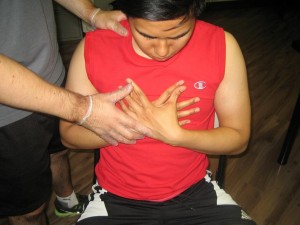Hyperventilation is breathing that is deeper and rapid than the normal rate. There is a decrease in the amount of gas in the blood which is also called carbon dioxide. The individual experiences a feeling of lightheadedness, rapid heartbeat and shortness of breath. It can also cause numbness and tingling in the hands or feet, fainting, anxiety and sore chest muscles.
Hyperventilation can be caused by fever, anxiety, certain medications, vigorous exercises and emotional stress. It can also be caused by some conditions such as asthma, emphysema or head injuries. Sometimes, hyperventilation can also occur among those who are tense or nervous, experience shallow breathing and suffer from conditions such as lung diseases and panic disorders. Women are more susceptible to experience hyperventilation than men. By enrolling in a class on first aid, you can properly manage the symptoms.
Symptoms

Hyperventilation can last for 20-30 minutes and includes the following:
- Frequent sighing or yawning
- Feeling anxious, nervous or tense
- Numbness or tingling sensation in the hands, feet and around the mouth.
- Problems with balance, lightheadedness or vertigo
- Feeling that there is not enough air to breath or there is a need to sit up in order to breathe properly.
- Throbbing and racing heartbeat
- Chest tightness, fullness, pressure, pain and tenderness
Other symptoms that can occur include bloating, gas or burping. There are also changes in vision such as blurry or tunnel vision. In addition, there are problems with concentration, memory and fainting.
Treatment and home remedies
- Breathe through pursed lips or pinch one nostril and breathe through the nose.
- Slow down the breathing to 1 breath for every 5 seconds in order to minimize the symptoms.
- Perform belly-breathing since it fills the lungs fully and slows down the breathing rate and allows the individual to relax.
- The individual should lie down on the floor and place one hand on the belly below the ribs with the other hand on the chest. This can also carried out by standing, but it is better to lie down with the knees bent. Take a deep breath through the nose and while inhaling, let the belly push the hand out, but keeping the chest still and while exhaling through pursed lips, feel the hand go down, use the hand on the belly in pushing all the air out and take time exhaling. Perform 3-10 times and take the time with each breath.
- Utilize a paper bag in controlling the breathing. Take 6-12 natural breath using a small paper bag held over the mouth and nose and then remove the bag from the nose and mouth and take easy on the natural breaths.
- Perform belly-breathing or diaphragmatic breathing. Alternate these techniques until the hyperventilation stops. In case hyperventilation continues for more than 30 minutes, seek medical help immediately.
